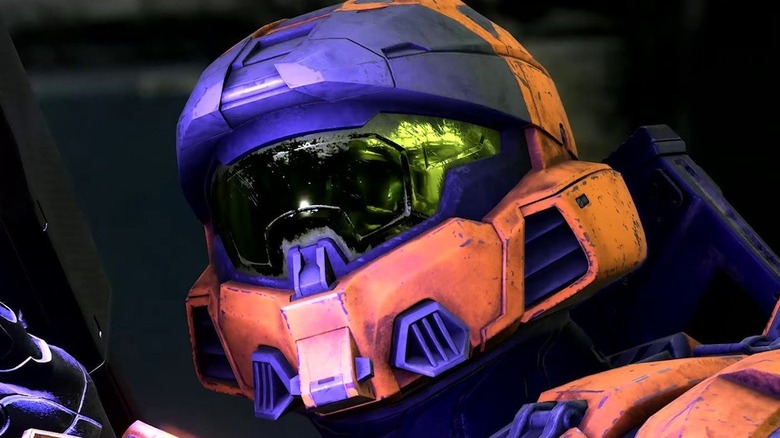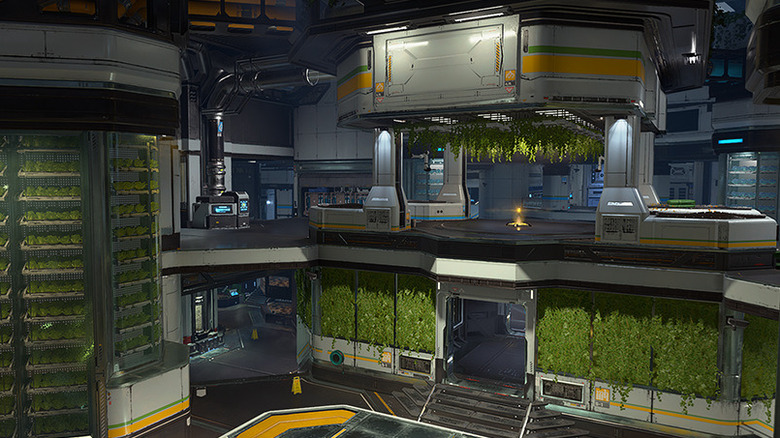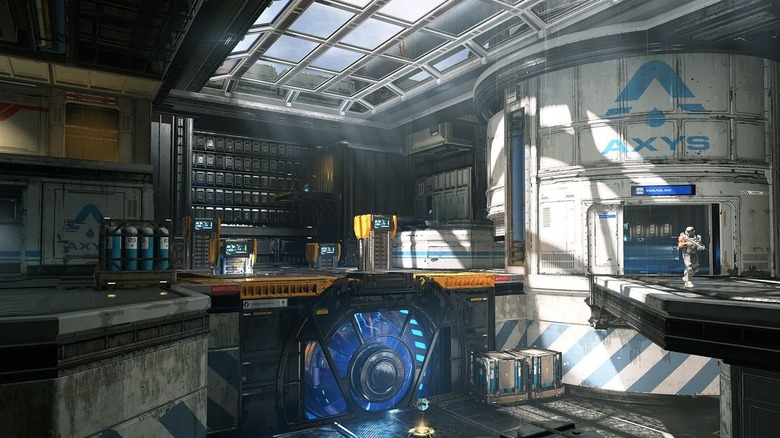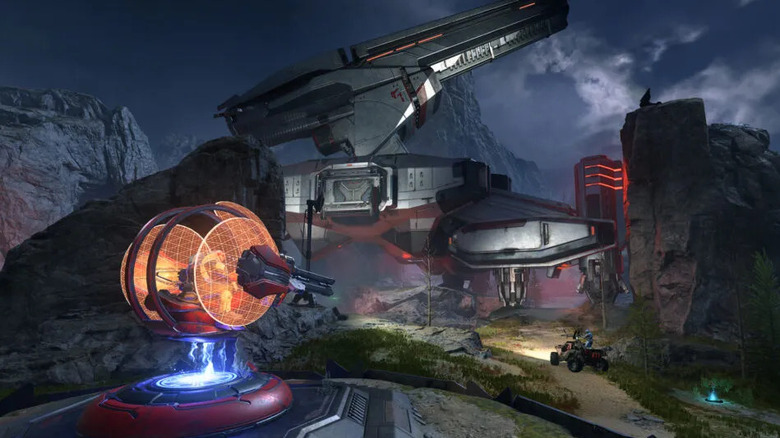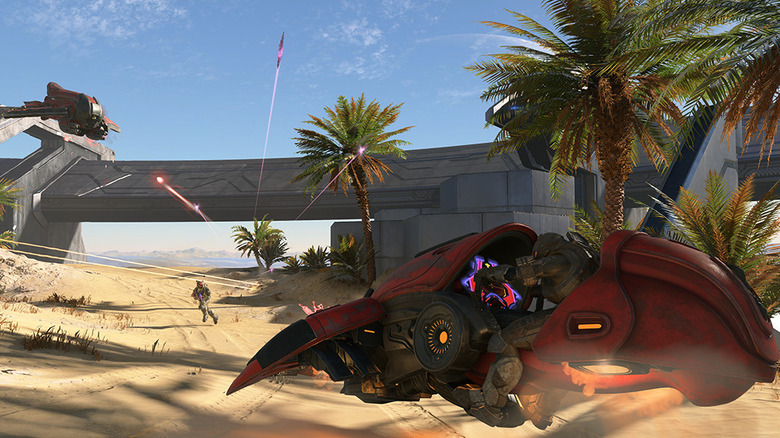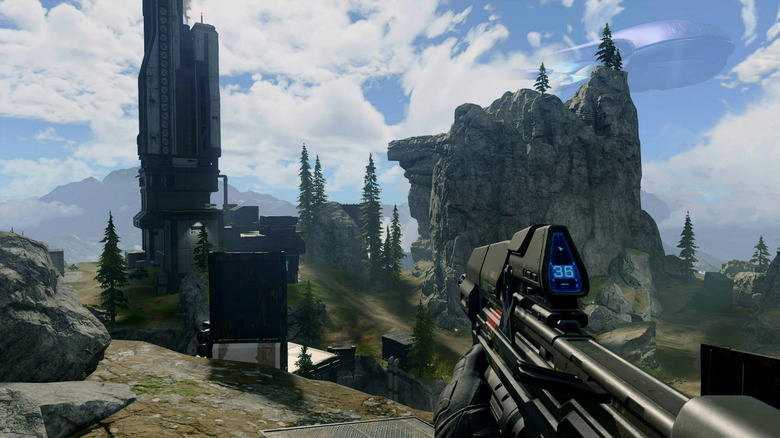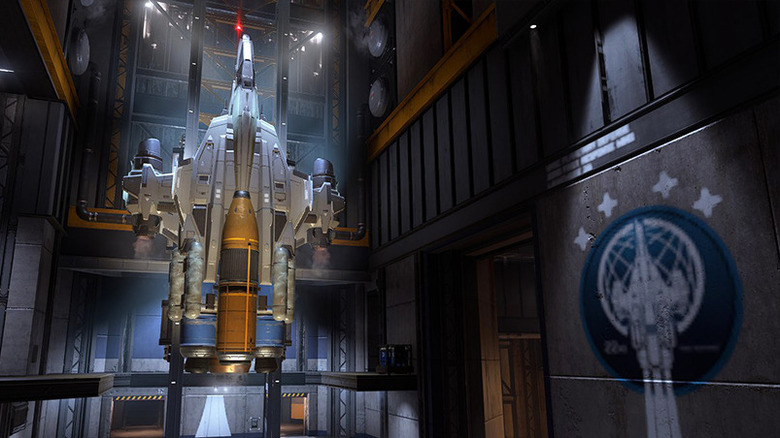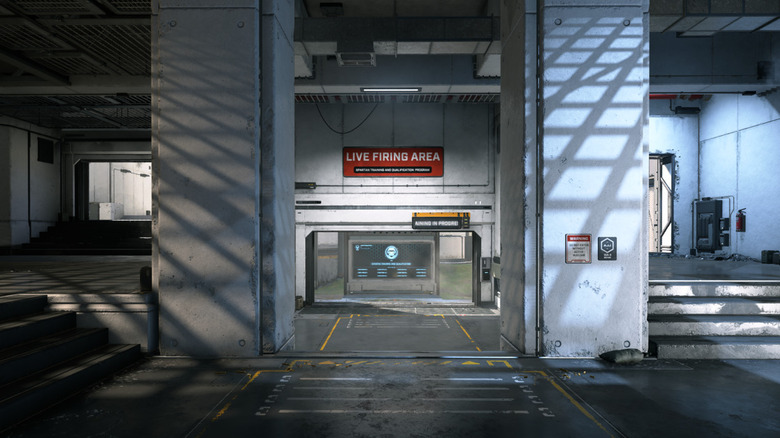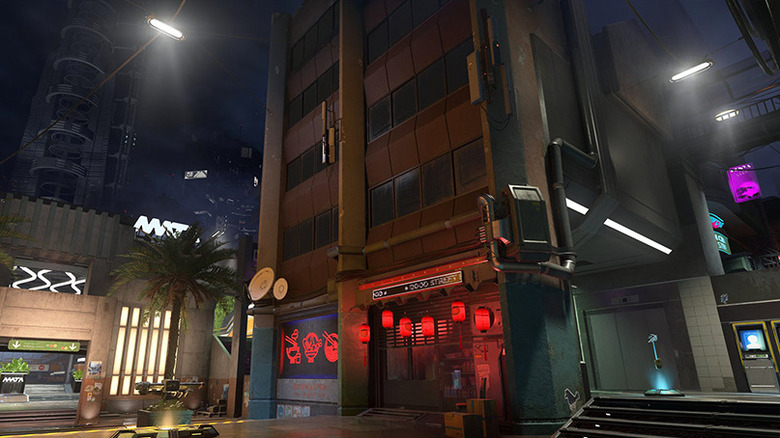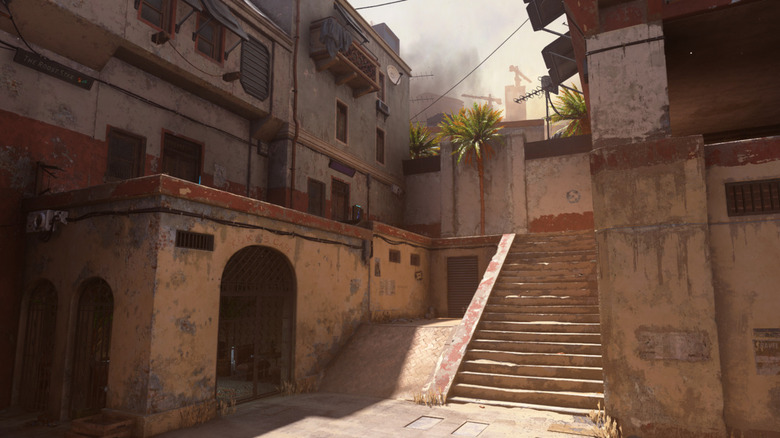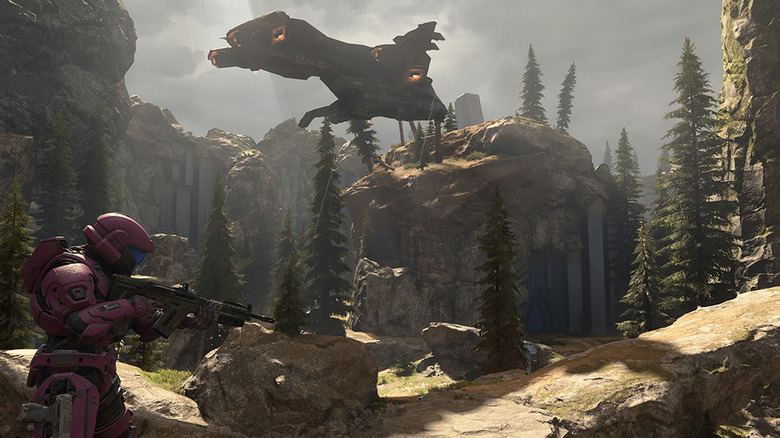Every Halo Infinite Multiplayer Map Ranked
First-person shooter games pride themselves on diverse and interesting maps. A multiplayer mode may be incredibly fun, but if the arenas themselves are lackluster, it bogs down the experience. Luckily, the multiplayer mode in "Halo Infinite" is no slouch when it comes to visually and mechanically complex locations. Multiplayer gameplay in the "Halo" series is comprised of vastly different game types, including classic modes like Capture the Flag and Slayer. The maps bolster the excitement of these modes, but some arenas feel like they were clearly built with a particular mode in mind.
From smaller quick match areas to large-scale big team battle stages, "Halo Infinite" multiplayer offers a lot of options for a free-to-play experience. Not only do they set the stage for multiplayer madness to ensue, but they are also visually stunning locales. Each of the maps feel unique, too; the cramped, neon-lit alleyway found in the Streets map immediately distinguishes itself from the greenery and verticality in Fragmentation's forest biome. Very little is carried over between maps, to the point where almost all of them feel absolutely essential. Each of the environments have their own unique design elements that increase replayability.
Ranking the maps in "Halo Infinite" is a tough task, as they all have their strengths when it comes to appearance and gameplay. Nevertheless, specific maps beg to be played again and again, whereas others may become redundant after just a few sessions.
10. Aquarius
Aquarius is the pinnacle of simplicity, and the basic symmetrical design can lead to repetitive encounters with opponents. Regardless, "Halo Infinite" multiplayer is so fast-paced that even this simplistic laboratory functions extremely well for standard deathmatch games.
At a glance, the map looks to be an unassuming indoor base, but there is much more going on, design-wise. Aquarius is a laboratory that focuses on botany research. As such, plant life is organized across the walls and shelves, adding some color to the industrial setting.
As a multiplayer map, however, the science base isn't particularly riveting. Starting locations on the second floor are very open and offer a few different pathways, which is a plus. Spartans can try to snipe opponents immediately, or hop off and charge enemy territory. Unfortunately, it's easy for players to find themselves drifting into the tight corridors on either side again and again. Because of its open design, hallways yield quick getaways — which means the majority of close-quarter encounters lead into these areas.
The compact are of play means strategy and experimentation aren't as common as they are in the more intricate environments. Ultimately, Aquarius isn't particularly enthralling, but there is fun to be had. Modes like Oddball make good use of the cramped arrangement, leading to more chaotic matches.
9. Recharge
A lot of the issues with Aquarius extend to Recharge as well. The only difference is how well this facility suits the classic "Halo" gameplay loop. Although it retains the bland interior appearance of Aquarius, Recharge makes up for it with a more labyrinthine structure.
The middle of the map has fairly standard high vantage points and exposed lower areas. What sets it apart, however, is the surrounding area. Winding maze-like passageways are abundant, and the Grappleshot pick-up makes moving up through the environment a total blast. Rather than slowly hopping on crates to reach higher points, the grapple can be utilized to quickly escape enemy fire.
The grappling hook isn't the only pickup that makes use of the terrain, as pushing opponents off to the lower levels with the Repulsor is extremely fun. The cramped hallways and stairs mean that melee-centric weapons like the gravity hammer and energy sword have a chance to shine. Camouflage can also be extremely helpful in this map, as well, allowing players to take advantage of the large number of interconnected hallways.
Recharge is a pretty traditional indoor stage, but the design demands that players be on their A-game.
8. Deadlock
Big Team Battle is a mode in "Halo Infinite" that pits two teams of 12 against each other. Gigantic, far-reaching maps like Deadlock are required for these war-like matches, and this one makes for quite the chaotic war zone.
In Deadlock, players spawn on opposing outdoor bases that diverge into three paths. A cavern is placed on one side, while a crash site is on another. Between these two points is a veritable no man's land: an open area of rocky terrain where kills and deaths will be abundant.
The map also leads to some wild vehicular combat. For starters, Warthog vehicles are available from the get-go, which encourages team members to immediately hop on together to go after objectives. Comparatively, Choppers are single-seat offensive transports that are best utilized for immediate kills. Rounding things out are the two Shade Turrets placed on opposing sides of the map. These can be mounted to put deadly pressure on different parts of the terrain.
Deadlock stands in stark contrast to Aquarius and Recharge, since claustrophobic hallways are nonexistent. The night-lit mountain region gives players free rein to see all of their surroundings. Because other players and vehicles are easy to spot, scoped weapons and accuracy are essential in order to succeed.
Deadlock's open design and relative lack of cover leads to a lot of stalemates, but it also encourages players to think outside the box when trying to escort seeds to their base or maintain total control of zones.
7. Behemoth
The desert map of Behemoth strikes a balance between smaller-scale interior settings and grand battlegrounds, acting as almost a middle ground among "Halo Infinite" maps.
A good portion of the map is a desert area that features jump ramps and occasional flying vehicles, such as the Banshee. One could spend a great deal of time on this part of the map and not interact with the middle-ground at all. Level design more akin to Aquarius and Recharge makes up the entire middle section of Behemoth, which features skinny underground passages leading to a precarious bridge. If players aren't careful, they may fall down into the pit below.
Behemoth isn't the largest map, so patrolling the perimeter in a Banshee can put the pressure on other players. Teams may find themselves fighting one another just to maintain control over the machine. Launching off a ramp and grappling to a Banshee just to toss its pilot out and regain control is an otherworldly feeling.
Behemoth is perfectly symmetrical, yet it still encourages exploration. Vehicles can monitor the outside while players can sneak their way up the middle, most weapons are viable, and pick-ups like the Overshield help increase survival and keep things fresh.
6. Highpower
The next Big Team Battle map is Highpower, a forest biome with a more nonlinear arrangement than Deadlock. Absolute chaos fills the screen when entering Highpower, no matter what side the player is on.
Highpower contains a huge list of vehicles including the Wasp, Mongoose, and Warthogs. All are accessed at the start of the match or through package drops mid-game. Whereas Behemoth incorporates vehicles as a strategic option to keep others in check, a number of the vehicles in Highpower are driven just to get from point A to point B. That's how expansive the map is.
The geography is extremely varied, including small canyons, caverns, ravines, and mountaintops, as well as a gaping crater that gets the better of even the most skilled Spartans. Landmarks such as these aren't for show, either, as they also operate as distinct spots for individual showdowns.
Highpower is designed in such a way that a team's strategy can completely change depending on the game mode. Slayer matches and Zone Captures are total unpredictable madness, thanks to players being respawned all over the map after every death. It can be difficult to stay alive on your way back to the main event, but Highpower's terrain allows for different approaches.
On the other side of things, modes like Capture the Flag can be a bit too chaotic when 12-person teams overrun the nonlinear map. In that case, players may want to have a Warthog handy to escort a flag holder all the way back to base.
5. Launch Site
So far, the maps in "Halo Infinite" have been described by their layouts and geographical landmarks. Aside from Aquarius' botany lab, very few locales have a wholly memorable theme. Launch Site stands out for its ability to display an engaging theme that runs through every design element.
This industrial base contains a Sabre ship getting ready for launch. Large loading bays include trucks and cargo to take cover behind. The launching ship is incredibly detailed and the multi-floor building surrounding it allows players to get a better look at the aircraft. The design of this location is top-notch, and luckily the gameplay follows that example.
A jump ramp can launch players over to the enemy's side, while other routes allow for cutting through buildings or sneaking through hallways leading to the back of the launchpad. If you're feeling more direct, you can also take a Warthog or Ghost through the main road to the launchpad.
An interesting feature of Launch Site is its distinct game type for Capture the Flag. Due to the asymmetrical design of the map, one mode features a single flag on the launchpad to either defend or capture. It can be an easier time to protect the flag rather than be on the offensive, but teams take turns on either side during rounds, so it's always fair.
4. Live Fire
At first glance, Live Fire is a stage that doesn't seem like a standout. There are no vehicles, ramps, or geographical highlights, and it's quite literally the tutorial level prior to joining online matches. Even so, Live Fire is a solid arena that perfectly encapsulates the best parts of "Halo Infinite" multiplayer gameplay.
One team begins at the high sniper point while another starts at a lower level home base. Both are relatively close to one another, separated by a tight corridor connecting the paths. A network of tunnels run beneath the starting area, which can be entered from in five different ways (with one of the most fun entrances being an escape panel in the ceiling).
Live Fire is another asymmetrical map, featuring vastly different designs on either side. One side has an exposed trail that leads around to the opponents' side, while the other features a high catwalk and a route that leads to the back of the primary sniping point.
There is a sort of synchronization between the open regions and tight spaces that offers quite a lot of strategy in completing objectives. Its small size is encouraging for melee enthusiasts, but there's still plenty of space for for assault and sniping weapons. Each of the gameplay modes in "Halo Infinite" become high-octane experiences when playing on Live Fire, which is a shock considering its standard appearance and small-scale structure. In every way, it's the perfect starter map.
3. Streets
Having an urban street environment is a must in first-person shooting games, and "Halo Infinite" masterfully delivers one in the Streets arena. An even playing field and a number of varied layers make returning to this unassuming map into an absolute joy.
Zone Capture is a good mode to help explain why the arena is so well-designed. One zone is placed within a corner building, which provides a sizable view of the map. Balancing out this advantage are the two stairway entry points. A solo player will have a rough time scoping out enemy players while keeping an eye on both entrances, which heightens the tension.
The map's base features different avenues to move about, including a sniping position, incline walkway, and an entryway for the three main routes. The other side of the map has none of this, but is instead an open area that has no fluff and lets players move directly to their desired location. The map's interconnected alleyways open into spacious routes that merge into one another, doing away with the cramped quarters of other arenas.
Visually, Streets is a gorgeous setting. Neon lights fill every alley as vending machines and odd graffiti help flesh out the world. Smaller details like hologram emblems and palm trees provide a nice finishing touch for an already spectacular-looking environment.
2. Bazaar
Bazaar combines all of the best elements of the smaller and regular-sized maps in "Halo Infinite," and some sections of the arena make for some of the most engaging shootouts in the game.
Towering doors are found on either side of the map, which are cracked open just enough so that one can get a quick glimpse at the main area. The biggest chunk of the map has high rise balconies that lead into smaller rooms. Players can drop from these balconies into the fray or retreat back down the stairs and find an alternate route. Bazaar also contains a side building with two staircases, which are handy for giving shooters an alternate angle on the vicinity.
Bazaar also has a distinct feel from other maps. Fruit stands occupy the vendor stores and chickens run rampant around the bazaar. Buildings are worn and crumbling while trash bags and dumpsters fill the streets. The map is melancholic in this way and sets itself apart from the more clean and industrial-looking stages.
Item and weapon pickups are also specifically placed in the more dangerous areas. Overshields are typically placed off to the side of the market, where enemies can immediately chase down anyone that tries to snag one. Likewise, melee weapons are dominant in the Bazaar due to its smaller and more intimate design. Close-quarters combat and immersive design make Bazaar one the best multiplayer maps in the game.
1. Fragmentation
Now take everything about Bazaar and toss it out the window. Fragmentation is a massive Big Battle Team map that is meant to be explored and revisited. The "Halo Infinite" campaign is mainly composed of a forest biome and Fragmentation implements these distinct settings into a near-perfect multiplayer map.
Fragmentation is the best playground for players to mess around with the game-changing Grappleshot. Swinging from trees and ascending hilltops makes Fragmentation feel less like a multiplayer map and more like a personal sandbox — just with people shooting at you. Mobility is an absolute joy in this forest region.
The mayhem is cranked up to eleven with the inclusion of vehicles and jump boost ramps. Both of these tools help streamline travel from one end to the other, so Fragmentation never feels exhausting to maneuver through. These additions also supports the completion of objectives, since it's easy to get back into the fight after dying and assist teammates in capturing zones or defending flags.
Fragmentation is so big in scope that vehicles and weapons never feel unbalanced. Item pickups all feel crucial and accessible, no matter where Spartans are situated. Lastly, if a route or game plan isn't working, this multiplayer layout offers ample opportunities to drop everything and try a different approach. There is always a way to contribute to your team when blasting through this biome, making Fragmentation the pinnacle of what "Halo Infinite" multiplayer has to offer.

